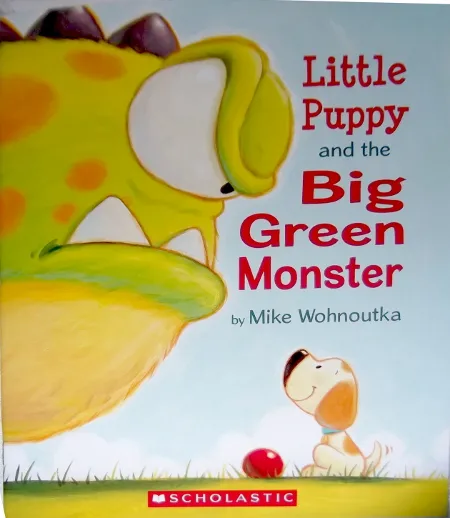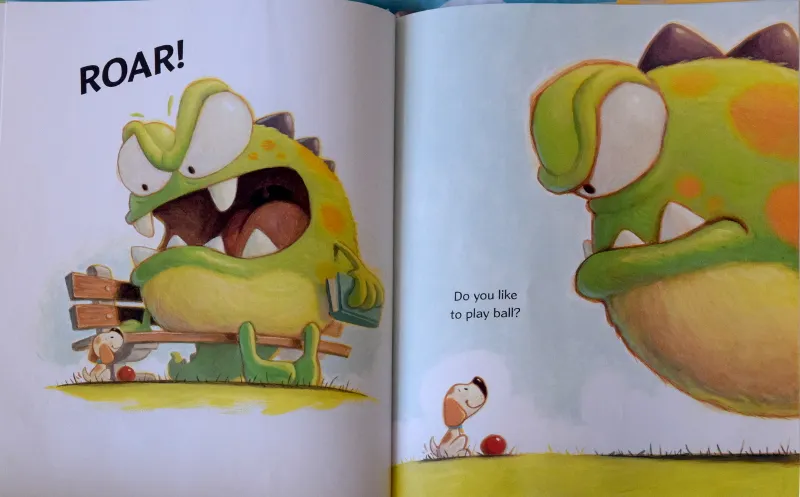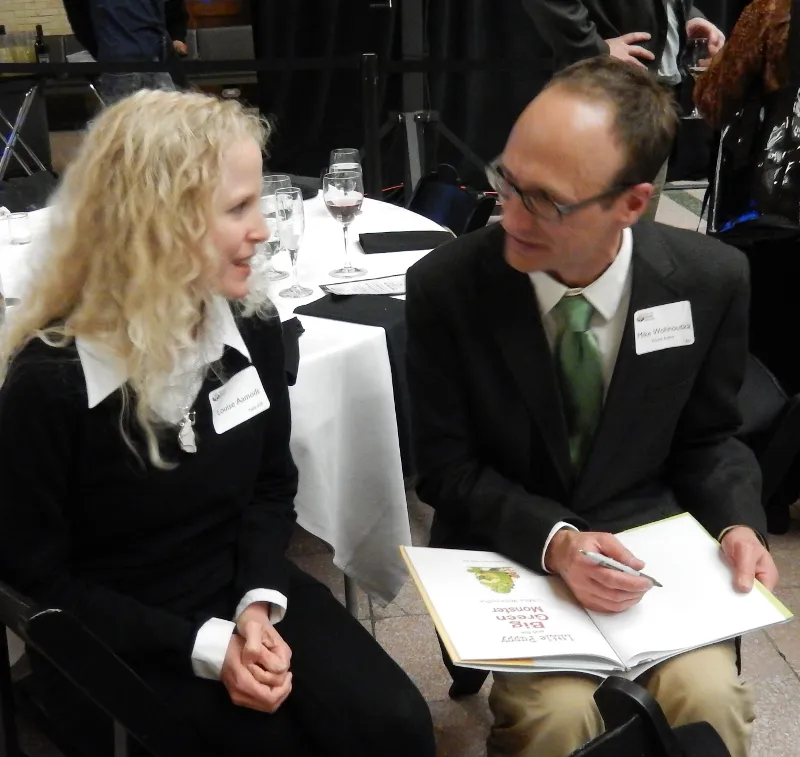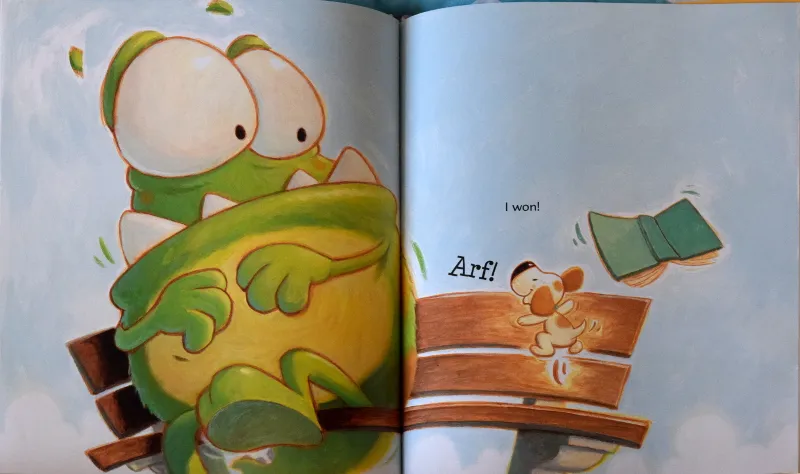Welcome to Dog Care Story, where we explore all facets of the pet world, including heartwarming tales that resonate with every dog owner. Today, we’re diving into a delightful children’s book that perfectly captures the essence of canine companionship and the joy of finding a playmate: Little Puppy and the Big Green Monster. This picture book, authored and illustrated by Mike Wohnoutka, is not just for young readers; it offers a charming perspective on unconditional love, perseverance, and the playful spirit that defines our furry friends.
Mike Wohnoutka’s Little Puppy and the Big Green Monster has garnered significant acclaim, becoming a Minnesota Book Award Finalist in 2015 and a Scholastic Book Club Selection. Designed for ages 2-5, it beautifully tells the story of a determined little puppy searching for someone to play with. This isn’t a book to rush through; its carefully chosen words and engaging illustrations invite readers to slow down and savor every moment of Little Puppy’s quest. The narrative pacing is masterfully controlled, setting the mood and creating visual breaks on each page, making it a joy to read aloud and experience the changing fonts that add a dynamic layer to the storytelling.
The Artistry Behind the Adventure
The illustrations in Little Puppy and the Big Green Monster are a true highlight, bursting with life and emotion. Wohnoutka’s use of color is particularly noteworthy, especially how the monster’s appearance introduces a vibrant splash to the existing palette, symbolizing the excitement and energy he brings. Readers will appreciate the diverse perspectives and angles, which add depth and movement to the story. However, it’s the spot-on facial expressions that truly convey the narrative’s joy, prompting giggles from children and adults alike. Even the end papers offer a mini-story, a charming detail that emphasizes the thoughtfulness embedded in every aspect of the book.
 The enchanting cover of "Little Puppy and the Big Green Monster" by Mike Wohnoutka
The enchanting cover of "Little Puppy and the Big Green Monster" by Mike Wohnoutka
The story of Little Puppy and the Big Green Monster revolves around Little Puppy’s tireless search for a playmate. He approaches various characters, each with their own reasons for being unable to join him. This narrative gently teaches young readers about perseverance and resilience, as Little Puppy never gives up hope. For pet owners, this mirrors the boundless energy and unwavering desire for connection that our own puppies often exhibit. The simple yet profound text allows the illustrations to shine, carrying much of the emotional weight and humor, making it an accessible and enjoyable read for its target audience.
A Deeper Look into Themes and Connections to Pet Ownership
The genius of Little Puppy and the Big Green Monster lies in its ability to convey profound messages through simple storytelling. The unconditional love and playful nature of a puppy are central themes, beautifully contrasted with the initial, perhaps overwhelming, presence of the “Big Green Monster.” This dynamic perfectly encapsulates the common experience of pet owners who, despite their busy lives, find themselves endlessly charmed by their pets’ persistent affections. It’s a reminder that even when we feel “too busy, too lazy, too mean, too boring, or often a big green monster of sorts,” our furry companions rarely change their delightful dispositions.
Mike Wohnoutka’s ability to craft such sparse text while ensuring his illustrations vividly convey the story is remarkable. For those of us who adore storytelling but lack artistic skills, this book highlights the powerful synergy between words and images. Subtle artistic details, such as a personalized mailbox, a quaint picket fence, the expressive “tail language” of Little Puppy, and the appearance of numerous rubber duckies, add layers of endearment to each page. These small touches create a rich, immersive world that enhances the reader’s connection to Little Puppy and his journey to find a friend.
 Little Puppy happily playing with the Big Green Monster, a moment of pure joy and companionship
Little Puppy happily playing with the Big Green Monster, a moment of pure joy and companionship
The story offers an excellent opportunity to discuss emotions with children, exploring disappointment, persistence, and ultimately, joy. For dog owners, it’s a beautiful reflection of the joy and comfort our pets bring into our lives. Little Puppy’s unwavering optimism and his refusal to give up resonate deeply, reminding us of the simple yet profound lessons our pets teach us every day. The book subtly encourages empathy and understanding, highlighting that even those who appear intimidating, like the Big Green Monster, can be wonderful friends.
The Author’s Optimism and Lasting Advice
Meeting an author-illustrator often adds another layer of appreciation to their work. Mike Wohnoutka, the creative force behind Little Puppy and the Big Green Monster, is described as being as animated as his Monster character, yet as friendly and enthusiastic as Little Puppy. This personal connection underscores the authentic spirit of his book. His core advice, “Don’t give up,” echoes Little Puppy’s journey and is a powerful message for everyone, regardless of age. It’s a testament to the fact that persistence often leads to wonderful discoveries, just as Little Puppy’s determination led him to his ultimate playmate.
 Mike Wohnoutka, the author and illustrator, sharing his creative insights
Mike Wohnoutka, the author and illustrator, sharing his creative insights
This advice transcends the pages of a children’s book, offering a valuable life lesson that applies to various challenges, including those in pet care. Whether training a new puppy, working through behavioral issues, or simply fostering a strong bond, patience and persistence are key. The optimistic spirit woven throughout Little Puppy and the Big Green Monster serves as a gentle reminder to approach life, and our relationship with our pets, with a positive and hopeful outlook.
Connecting with Our Furry Friends
Little Puppy and the Big Green Monster is more than just a delightful story; it’s a poignant reminder of the simple yet profound bond we share with our pets. It evokes feelings of nostalgia for past companions and encourages us to be more like Little Puppy – full of unconditional love, playfulness, and unwavering optimism. The journey of Little Puppy and the Big Green Monster beautifully illustrates how a bit of persistence and an open heart can lead to the most joyous connections.
 Little Puppy's joy after a successful play session, a testament to his perseverance
Little Puppy's joy after a successful play session, a testament to his perseverance
We at Dog Care Story believe that understanding these dynamics enriches our lives and deepens our appreciation for our beloved dogs. This book, while for children, speaks volumes to the adult heart, especially those who cherish their canine companions. It’s a perfect addition to any family’s bookshelf, offering both entertainment and a valuable message about enduring friendship.
Conclusion: A Timeless Tale of Play and Perseverance
Little Puppy and the Big Green Monster by Mike Wohnoutka stands out as a charming and insightful picture book that resonates with both young readers and pet owners. Its beautiful illustrations, sparse yet impactful text, and heartwarming themes of perseverance, unconditional love, and the joy of play make it a standout. The book masterfully captures the spirit of a little puppy’s relentless search for a playmate, ultimately delivering a message that “don’t give up” can lead to the most rewarding friendships. This story is a testament to the simple yet powerful lessons our pets teach us about joy and connection.
We encourage you to pick up this book and share the delightful adventure of Little Puppy and the Big Green Monster with the children (and perhaps the dogs!) in your life. It’s a wonderful read that celebrates the precious bond between living creatures. Explore more articles on Dog Care Story for tips on nurturing that special connection with your furry family members!
